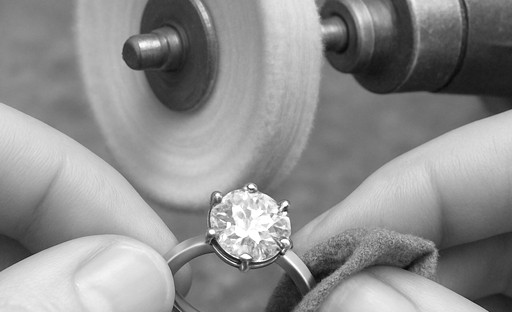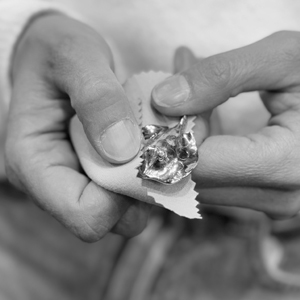
Silver and gold jewelry are everyday accessories—whether it’s a classic necklace, a modern ring, or a vintage heirloom. Over time, even the best-maintained pieces can lose their luster, oxidize, or accumulate dirt. While many try DIY methods, professional cleaning is often the most effective solution.
WHY DO PRECIOUS METAL JEWELRY TARNISH?
Oxidation is a natural chemical reaction caused by hydrogen sulfide in the air. Like silver, gold jewelry can oxidize—though the process is more visible and occurs more quickly on silver. Discoloration can also be accelerated by sweat, lotions, perfumes, an acidic body pH, and especially thermal water, all of which can blacken precious metals.
When You should see a professional?
· For valuable, antique, or heirloom pieces with delicate surface treatments.
· For jewelry containing gemstones, which may react to certain chemicals.
· For heavily tarnished, discolored, or scratched items that cannot be safely restored at home.
· If you wear the jewelry regularly and want to maintain it long-term.
Why professional cleaning is better?
· Expertise: Professionals know exactly what materials and methods to use on each piece.
· Safety: Prevents accidental scratching, gemstone loss, or material damage.
· Longevity: Regular professional maintenance significantly extends a piece’s lifetime.
PROFESSIONAL CLEANING – STEP BY STEP
1. Tumble-vibe cleaning
The fastest and most reliable method. Tiny metal balls vibrate in water to polish the jewelry. This does not scratch but also doesn’t remove deep scratches—however, it effectively removes oxidized layers. Suitable for all precious metal surfaces, such as antique, carved, set with stones, smooth, or rustic. Note: it can remove the gold plating, so re-galvanization may be neccessary afterward.
2. Ultrasonic cleaning
Ultrasonic machines are now available for home use. Ultrasonic cleaning is not a proven method in all cases, the results are most noticeable on jewelry with small zirconia stones. The ultrasonic machine uses micro-vibrations to remove dirt between stones, so that they shine beautifully again-but, it does not polish or remove oxidation. The disadvantage is that stones can often fall out during the process, and it is prohibited to use it on jewelry with glued stones.
3. Machine polishing
Machine polishing removes micro-scratches and abrasions beautifully. This step comes after the tumbler cleaning once the jewelry item is no longer tarnished. It's a meticulous and time-consuming process. Various heads on the polishing machine can create a mirror-like finish on precious metals.

4. Chemical cleaning
Chemical cleaning is necessary, if the precious metals are very black, for example, in the case of oxidation caused by sulfurous thermal waters. Chemical baths are available for home use, but their effect is not always beneficial – in short term they really make silver jewelry shiny, but in the long term they accelerate the oxidation process. For this reason it is very important to perform a tumble-vibe cleaning after the chemicals. These solutions work with controlled pH and duration. Some gemstones can react badly, chemical cleaning is not recommended for home use.
5. Cleaning Cloths
Chemical-infused polishing cloths are widely available for home use and require little attention. However, they aren’t very effective on oxidation and can't clean jewelry with small stones. Best for temporarily refreshing smooth-surface pieces.

HOME PRACTICES FOR CLEANING SILVER
Many home silver-cleaning methods are popular online. We’ll list them here, but they are not recommended as the best solutions.
1. Aluminum foil method
· Line a bowl with shiny-side-up aluminum foil.
· Place the jewelry in contact with the foil.
· Sprinkle baking soda on top.
· Pour boiling water until jewelry is submerged.
· Wait 5–10 minutes, rinse with clean water, and dry with a soft cloth.
2. Vinegar method
· Mix vinegar and baking soda in a small bowl.
· Soak the jewelry for 2–3 hours.
· Rinse and dry thoroughly.
3. Toothpaste Method
· Use a non-gel, white, non-abrasive toothpaste.
· Apply a small amount to a soft cloth or toothbrush.
· Gently rub the jewelry.
· Rinse with warm water and dry.
These home methods are widespread, but not recommended by professionals.
PREVENTION – HOW TO KEEP YOUR JEWELRY SHINY LONG-TERM
· Store silver jewelry in airtight bags.
· Keep separate from other items to avoid scratches.
· Wipe with a soft cloth after wearing.
· Remove before bathing or sleeping—your jewelry will thank you.
· Rhodium plating (from the platinum family) protects silver from oxidation. Any silver piece can be rhodium-plated. Rhodium doesn't tarnish but can wear off over time.
While foil and baking soda might work at home, valuable silver jewelry deserves professional care. Feel free to contact us—our expert team is always up to date and ready to make your jewelry shine again.


